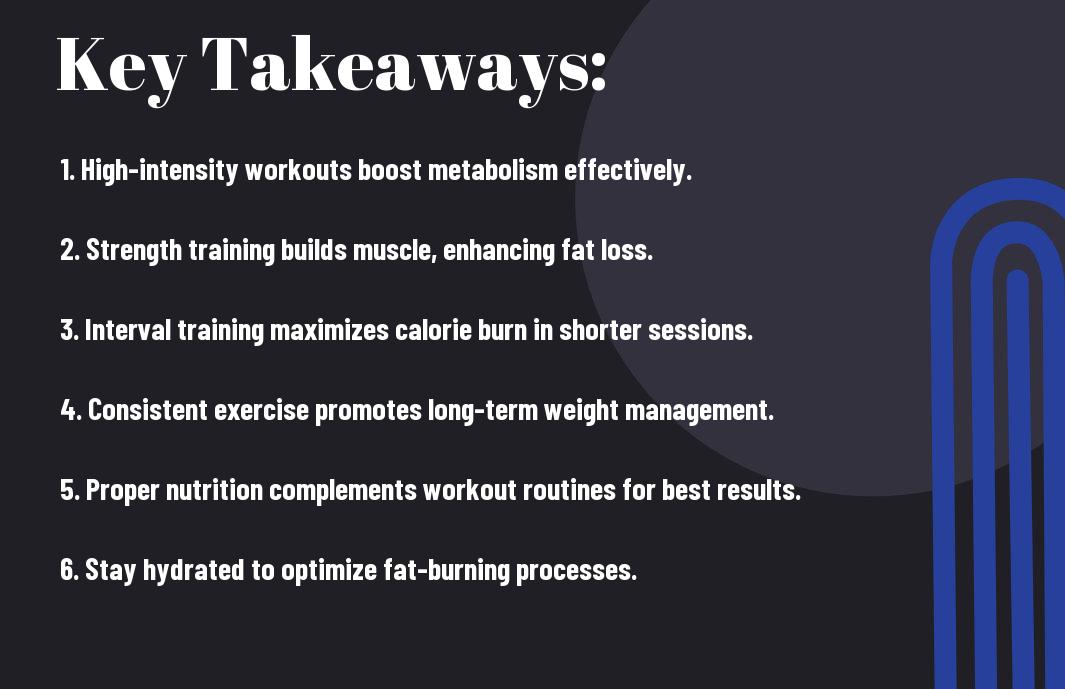Just understanding how fat burning workouts operate can significantly enhance your weight loss journey. By incorporating specific exercises into your routine, you can accelerate your metabolism, optimize your body’s fat utilization, and achieve your fitness goals more efficiently. This blog post will examine into the science behind fat burning, explaining how different workouts target fat stores, impact energy expenditure, and contribute to effective weight loss, so you can make informed choices for your fitness plan.
Key Takeaways:
- High-Intensity Interval Training (HIIT) maximizes fat burning by alternating short bursts of intense exercise with recovery periods, leading to increased calorie expenditure even after workouts.
- Strength Training builds muscle mass, which in turn boosts metabolism, allowing the body to burn more calories at rest and promote fat loss.
- Cardio Workouts, especially steady-state cardio, help improve cardiovascular health and enhance fat oxidation, making them effective for weight management.

Understanding Fat Metabolism
While the journey of fat metabolism is often misunderstood, it’s vital to grasp how the body converts stored fat into usable energy. Your body is constantly in a state of energy balance, and it utilizes fat as a fuel source during activities like exercise and daily tasks. (Understanding this process can help you make more informed choices about your workouts and nutrition.)
How the Body Burns Fat
Below the surface, your body burns fat through a complex interplay of hormones and metabolic pathways. Fat cells release fatty acids into the bloodstream, which can then be used for energy during low-intensity workouts or while at rest. (Choosing the right type of exercise can optimize this fat-burning process.)
Factors Influencing Fat Loss
About fat loss, various factors can impact your results, including diet, exercise intensity, and even genetics. Your daily caloric intake, the types of food you consume, and your workout routine all play significant roles in fat metabolism. (Paying attention to these factors can greatly enhance your fat loss journey.)
- Diet quality and quantity
- Exercise frequency and intensity
- Sleep quality and stress levels
Knowing how these elements affect your body can empower you to make better lifestyle choices.
Also, considering your unique physiology is necessary in understanding fat loss. Factors like age, gender, and overall metabolism can influence how efficiently your body burns fat. (Acknowledging these individual differences can lead to more tailored, effective strategies for weight loss.)
- Your age and metabolic rate
- Hormonal balance
- Body composition
Knowing these distinctions allows you to approach fat loss in a more personalized manner.
The Role of Exercise in Weight Loss
Some people believe that diet alone is sufficient for weight loss, but exercise plays a significant role in achieving your goals. Regular physical activity not only burns calories but also stimulates metabolism, promoting fat loss while preserving lean muscle mass. By integrating workout routines into your lifestyle, you enhance your overall health, improve your mood, and boost your energy levels, all of which are important for sustainable weight loss.
Aerobic vs. Anaerobic Workouts
Among the various types of exercise, aerobic workouts, like running and cycling, focus on endurance and cardiovascular fitness, while anaerobic workouts, such as weight lifting, build strength and muscle mass. (Choosing the right balance between these workouts is important for optimal fat loss.)
The Importance of Strength Training
Importance of strength training cannot be overstated when it comes to weight loss. Not only does it help you build lean muscle, which burns more calories at rest, but it also improves your metabolism over time. By incorporating strength training into your routine, you enhance your body’s ability to utilize fat for energy, making your workouts more effective. Additionally, strength training fosters better body composition, giving you the toned look you desire while supporting your overall health.
Considering the multifaceted benefits of strength training, you should aim to include resistance exercises in your weekly workout schedule. This approach will not only contribute to weight loss but also promote a healthier lifestyle. Whether you prefer free weights, resistance bands, or bodyweight exercises, find a routine that fits your preferences and goals. Gradually increasing the intensity and complexity of your strength workouts can lead to continuous progress and improved results.

High-Intensity Interval Training (HIIT)
Unlike traditional steady-state cardio workouts, High-Intensity Interval Training (HIIT) involves alternating short bursts of intense activity with periods of rest or low-intensity exercise. This approach keeps your heart rate elevated, leading to more calories burned in a shorter timeframe. HIIT is particularly effective for fat burning, as it helps to increase your metabolic rate even after your workout has finished, maximizing the benefits in a limited amount of time.
Benefits of HIIT for Fat Burning
After engaging in HIIT, you may notice significant improvements in both your endurance and metabolic efficiency. This type of training not only burns a high number of calories during the workout itself but also contributes to the afterburn effect, where your body continues to burn calories at an elevated rate post-exercise. Additionally, HIIT is time-efficient, making it easier to fit into your busy lifestyle while still achieving effective fat loss results.
Sample HIIT Workouts
HIIT workouts can be varied and tailored to suit your fitness level and personal preferences. You might start with a basic circuit that includes exercises like sprinting, burpees, and jumping jacks, performed in intervals of 30 seconds on followed by 30 seconds off, repeating several rounds. This variation keeps your routine exciting and engages multiple muscle groups.
Another option for your HIIT workouts includes exercises such as kettlebell swings, mountain climbers, and squat jumps. You can structure these sessions with 20 seconds of intense work followed by 10 seconds of rest, using a Tabata format. This allows for maximum effort in a compressed timeframe, ensuring you benefit from both strength and cardio improvements while effectively targeting fat loss. You can always switch up your exercises to keep it fresh and challenging.
The Science Behind Steady-State Cardio
Despite its simplicity, steady-state cardio is an effective method for enhancing fat loss. Engaging in activities like jogging, cycling, or swimming at a consistent pace allows your body to tap into fat stores for energy. This low to moderate-intensity exercise supports endurance while creating a caloric deficit, crucial for weight loss.
Effects on Fat Oxidation
An important aspect of steady-state cardio is its influence on fat oxidation. At moderate intensity, your body shifts its energy source towards stored fats, effectively promoting fat burning during and after your workout. This adaptation helps your body become more efficient in using fat as fuel, aiding in long-term weight loss goals.
Choosing the Right Duration and Intensity
Any beginner or seasoned athlete can benefit from understanding the appropriate duration and intensity for steady-state cardio. Finding the right balance is important for optimizing fat burning while preventing fatigue and burnout.
For instance, aiming for sessions lasting 30 to 60 minutes at a heart rate of 60-75% of your maximum can help maximize fat oxidation without overexerting yourself. Listening to your body is important, allowing you to adjust your workout duration and intensity as needed. Gradual progression will enable you to build endurance while keeping the workouts enjoyable and sustainable.
Nutrition and Fat Burning
Not fueling your body properly can hinder your fat-burning efforts. Your nutrition plays a significant role in shaping how efficiently your body metabolizes fat. When you consume a well-balanced diet rich in whole foods, lean proteins, healthy fats, and complex carbohydrates, your body can function optimally and utilize stored fat more effectively. (Choosing a nutrition plan that suits your lifestyle can greatly enhance your results.)
The Impact of Diet on Fat Loss
Around 80% of your fat loss success is influenced by your diet. Consuming a variety of nutrient-dense foods helps provide your body with the important vitamins and minerals it needs while also keeping you satisfied. When you make informed food choices, you are more likely to create a calorie deficit, leading to fat loss. This means that simply exercising without paying attention to your diet can reduce the effectiveness of your workouts.
Pre- and Post-Workout Nutrition
Loss of muscle and energy can be mitigated through proper pre- and post-workout nutrition. Eating the right foods before your workouts ensures you have enough energy to perform at your best, while post-workout nutrition aids in recovery and muscle building. Both meals should incorporate a balance of carbohydrates and protein, which provides fuel for your muscles during exercise and promotes healing afterward.
Nutrition plays an important role in maximizing the benefits of your workouts. Consuming a meal or snack rich in carbohydrates and protein before exercising helps you maintain energy levels, allowing for enhanced performance. After your workout, aim to consume a nutritious meal that supports recovery by replenishing glycogen stores and repairing muscle tissue. This strategy will not only help you feel better post-workout but will also significantly contribute to effective fat burning and overall results.
Common Myths About Fat Burning
For many, fat burning is shrouded in myths that can hinder your weight loss journey. A common belief is that engaging in long, slow cardio sessions is the only way to shed fat. However, this oversimplification overlooks various effective strategies that incorporate strength training and high-intensity workouts, which can also play significant roles in your fat-loss efforts.
Debunking Popular Misconceptions
With numerous sources of misinformation, it’s easy to fall prey to fat-burning myths. One popular misconception is that you can target fat loss in specific areas of your body through localized exercises. In reality, your body decides where it loses fat based on genetics and overall body composition—focus on a comprehensive workout regimen instead.
Evidence-Based Insights
With ongoing research in exercise science, various studies demonstrate that fat burning is more complex than previously thought. Evidence shows that combining different types of workouts, including strength training and high-intensity interval training (HIIT), can optimize your metabolic rate, leading to more effective fat loss. Additionally, body composition changes often take precedence over just weight loss, emphasizing the importance of gaining muscle while losing fat.
Evidence-based insights suggest that incorporating a balanced mix of cardiovascular exercise, strength training, and flexibility work can significantly enhance your fat-burning capabilities. Research indicates that engaging in strength training not only builds muscle but also increases your basal metabolic rate, enabling your body to burn more calories at rest. Further studies advocate for the inclusion of high-intensity workouts, which have been shown to elevate your metabolic rate even after the workout has ended. By focusing on a well-rounded fitness approach, you can empower your body to effectively burn fat while enhancing overall health and fitness.
To wrap up
So, understanding the science of fat burning helps you choose workouts that effectively aid in weight loss. Incorporating high-intensity interval training, strength training, and steady-state cardio into your routine can elevate your metabolism and promote fat oxidation. By being mindful of your workout intensity and duration, you can maximize your body’s fat-burning capabilities. Moreover, combining these workouts with a balanced diet will further enhance your results. Ultimately, you have the tools to optimize your weight loss journey and achieve your fitness goals through strategic exercise choices.
Q: How do fat-burning workouts differ from regular workouts?
A: Fat-burning workouts are designed to maximize the number of calories you burn during and after exercising. These workouts typically incorporate a mix of cardiovascular and strength training exercises, emphasizing higher intensity levels and shorter rest periods. This approach helps increase your heart rate, promoting a greater energy expenditure. In contrast, regular workouts might focus more on endurance or strength without necessarily prioritizing fat loss. The key to effective fat-burning workouts lies in their ability to engage multiple muscle groups and boost your metabolism, making the body burn fat even at rest.
Q: What type of exercises are considered effective for fat burning?
A: Effective fat-burning exercises include High-Intensity Interval Training (HIIT), circuit training, and compound exercises like squats, deadlifts, and push-ups. HIIT workouts alternate between short bursts of intense activity and rest or lower intensity periods, which can lead to substantial calorie burning in a shorter time. Circuit training keeps the heart rate elevated by moving quickly from one exercise to another. Compound exercises work for multiple muscle groups simultaneously, enhancing calorie expenditure during and after the workout. Incorporating a variety of these exercises into a fitness routine can significantly promote fat loss.
Q: How often should I do fat-burning workouts to see results?
A: To see noticeable results from fat-burning workouts, it’s generally recommended to engage in them at least 3 to 5 times a week. Integrating these workouts into a well-rounded fitness program that includes rest days and strength training can help optimize fat loss. Consistency is vital, so finding a schedule that fits your lifestyle is vital. Additionally, pairing these workouts with a balanced diet can enhance the effectiveness of your routine and contribute to long-term weight loss success.










Reply